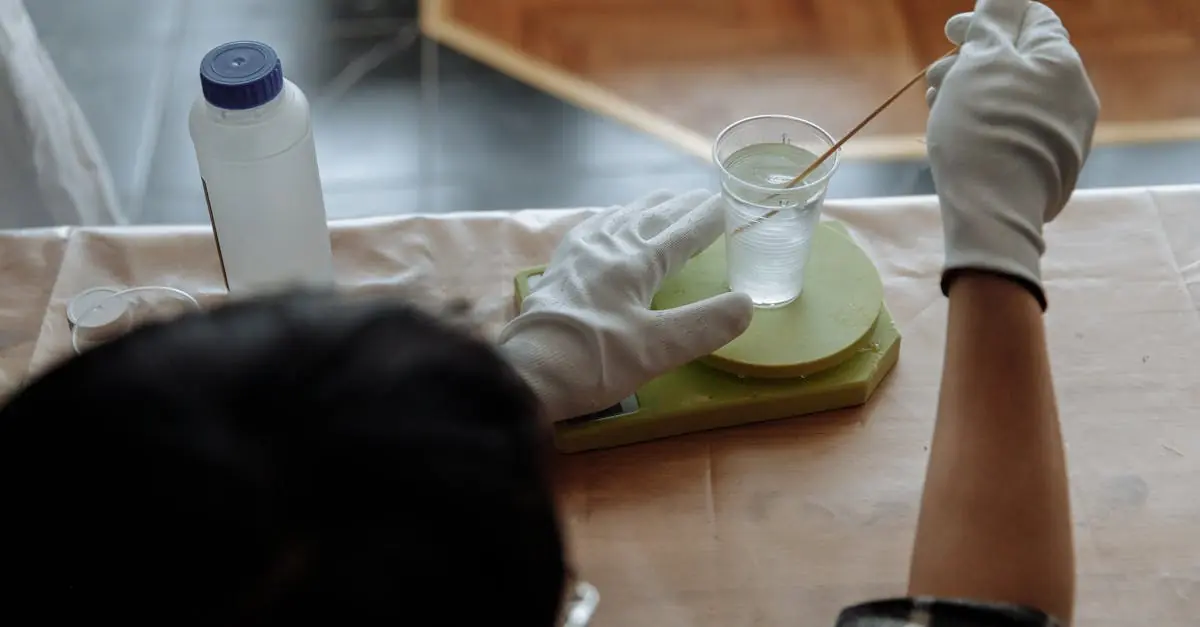When it comes to photopolymer resin, safety isn’t just a buzzword—it’s a must! While this magical goo can transform your creative ideas into stunning 3D prints, it can also pack a punch if not handled properly. Think of it as the superhero of the crafting world, but even superheroes need a sidekick to keep things safe.
Table of Contents
ToggleOverview of Photopolymer Resin Safety
Understanding photopolymer resin safety is crucial for anyone engaged in 3D printing. It contains chemicals that can pose health risks if not properly managed. Protective equipment plays a vital role in minimizing exposure.
Using gloves ensures skin contact with the resin is avoided. Safety goggles protect the eyes from splashes and UV light. A well-ventilated workspace helps reduce inhalation of fumes, contributing to a safer working environment.
In addition to personal protective gear, proper storage of photopolymer resin is essential. Keeping resin in a cool, dark place prevents degradation and theft. Labeling containers with clear hazard warnings enhances safety awareness.
Cleaning spills immediately aids in preventing accidents. Employing absorbent materials, such as paper towels or rags, helps manage small spills effectively. Disposal of used resin and cleaning materials must follow local regulations to ensure environmental safety.
Awareness of potential skin irritations and allergic reactions can prevent complications. Monitoring for any signs of adverse effects, such as rashes or respiratory discomfort, prompts timely medical attention. Always following manufacturer guidelines assists in maximizing safety practices.
Regular training on safe handling techniques reinforces a culture of safety within any 3D printing team. Sharing knowledge about the risks and safety measures creates a more informed and cautious work environment. Prioritizing safety not only protects individuals but also promotes overall resource efficiency in the crafting process.
Common Hazards Associated with Photopolymer Resins
Photopolymer resins pose several hazards during usage. Awareness of these risks is crucial for safe handling and use.
Inhalation Risks
Inhalation of photopolymer resin fumes can cause respiratory irritation. Users may experience symptoms such as coughing, dizziness, or headaches. Ventilation plays a vital role in minimizing these risks; ensuring adequate airflow in the workspace reduces the concentration of harmful vapors. Wearing an appropriate mask further protects against inhaling airborne particles. Regular monitoring of air quality can also help maintain a safe environment.
Skin Contact Risks
Skin contact with photopolymer resin can lead to irritations or allergic reactions. Direct exposure may result in redness, itching, or even severe dermatitis in sensitive individuals. Protective gloves must be worn to safeguard against such risks; nitrile gloves offer better resistance than latex. Promptly washing any resin off the skin with soap and water can mitigate irritation. Implementing safe handling practices, such as using tools instead of bare hands, helps reduce the likelihood of contact.
Eye Protection Requirements
Eye protection is essential when working with photopolymer resins. Splashes or accidental exposure to UV light can damage the eyes, leading to serious injuries. Safety goggles equipped with side shields provide full coverage and protect against flying particles. It’s critical to avoid using regular glasses since they do not offer adequate protection. Ensuring that goggles meet appropriate safety standards enhances safety during tasks involving photopolymer resin.
Proper Handling Procedures
Safe handling of photopolymer resin requires adherence to specific procedures. Prioritizing safety ensures a secure and efficient crafting experience.
Personal Protective Equipment (PPE)
Protective gloves guard against skin contact with photopolymer resin. Safety goggles offer essential eye protection from splashes and UV exposure. Masks are vital for filtering out harmful fumes, especially in poorly ventilated areas. Selecting high-quality PPE contributes to overall safety during 3D printing projects. Regularly inspecting PPE for wear or damage helps maintain maximum protection.
Storage and Disposal Guidelines
Store photopolymer resin in a cool, dark location to prevent degradation. Always label containers with hazard warnings for easy identification. Utilizing sealed containers minimizes the risk of spills and contamination. Dispose of used resin and cleaning materials in accordance with local regulations to prevent environmental harm. Following proper disposal methods fosters a safe and responsible approach to handling photopolymer resin.
Safety Measures During Use
Ensuring safety during the use of photopolymer resin involves various precautions and practices. Adhering to specific guidelines significantly reduces risks associated with this material.
Ventilation Requirements
Ventilation plays a crucial role in maintaining a safe workspace. Open windows and use exhaust fans to promote airflow and disperse potentially harmful fumes. Setting up a fume hood or utilizing an air filtration system enhances air quality while working with resin. Maintaining a fresh air exchange minimizes inhalation risks, particularly during resin application and curing processes.
Emergency Response Protocols
Establishing emergency response protocols is vital for effectively handling accidents. Keep an emergency kit stocked with materials like absorbent pads, gloves, and first aid supplies readily available. In case of skin contact, immediately wash the area with soap and water; seek medical assistance if irritation persists. For eye exposure, rinse eyes thoroughly with water and consult a medical professional. Training staff in emergency procedures ensures swift reactions, minimizing health risks and promoting a safe working environment.
Prioritizing safety when working with photopolymer resin is essential for a successful and enjoyable 3D printing experience. By adhering to proper safety protocols and utilizing protective equipment, individuals can significantly reduce health risks associated with resin use.
Creating a well-ventilated workspace and keeping emergency response plans in place further enhances safety. Continuous education on handling techniques and awareness of potential hazards fosters a culture of responsibility within the crafting community.
Ultimately, taking these precautions not only protects individuals but also promotes a more efficient and sustainable approach to 3D printing.

